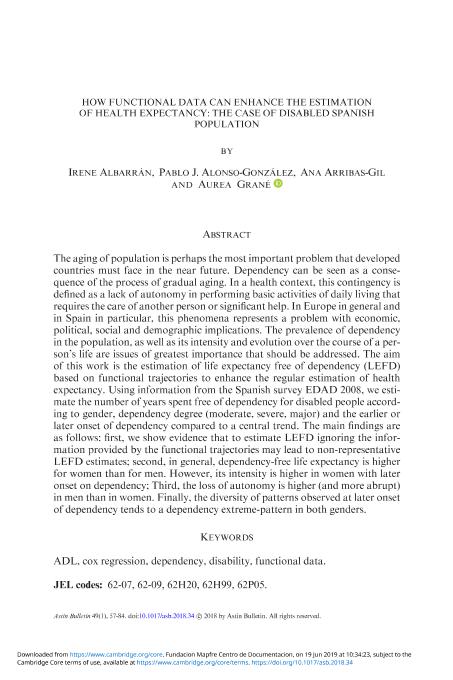How functional data can enhance the estimation of health expectancy : the case of disabled Spanish population

Contenido multimedia no disponible por derechos de autor o por acceso restringido. Contacte con la institución para más información.
| Tag | 1 | 2 | Value |
|---|---|---|---|
| LDR | 00000cab a2200000 4500 | ||
| 001 | MAP20190019101 | ||
| 003 | MAP | ||
| 005 | 20190625124239.0 | ||
| 008 | 190619e20190101gbr|||p |0|||b|eng d | ||
| 040 | $aMAP$bspa$dMAP | ||
| 084 | $a6 | ||
| 100 | 1 | $0MAPA20080120993$aAlbarrán, Irene | |
| 245 | 0 | 0 | $aHow functional data can enhance the estimation of health expectancy$b: the case of disabled Spanish population$cIrene Albarrán... [et al.] |
| 300 | $a28 p. | ||
| 520 | $aThe aging of population is perhaps the most important problem that developed countries must face in the near future. Dependency can be seen as a consequence of the process of gradual aging. In a health context, this contingency is defined as a lack of autonomy in performing basic activities of daily living that requires the care of another person or signi?cant help. In Europe in general and in Spain in particular, this phenomena represents a problem with economic, political, social and demographic implications. The prevalence of dependency in the population, as well as its intensity and evolution over the course of a person's life are issues of greatest importance that should be addressed. The aim of this work is the estimation of life expectancy free of dependency (LEFD) based on functional trajectories to enhance the regular estimation of health expectancy. Using information from the Spanish survey EDAD 2008, we estimate the number of years spent free of dependency for disabled people according to gender, dependency degree (moderate, severe, major) and the earlier or later onset of dependency compared to a central trend. The main findings are as follows: first, we show evidence that to estimate LEFD ignoring the information provided by the functional trajectories may lead to non-representative LEFD estimates; second, in general, dependency-free life expectancy is higher for women than for men. However, its intensity is higher in women with later onset on dependency; Third, the loss of autonomy is higher (and more abrupt) in men than in women. Finally, the diversity of patterns observed at later onset of dependency tends to a dependency extreme-pattern in both genders. | ||
| 650 | 4 | $0MAPA20080602437$aMatemática del seguro | |
| 650 | 4 | $0MAPA20080625597$aEnvejecimiento de la población | |
| 650 | 4 | $0MAPA20080557799$aDependencia | |
| 650 | 4 | $0MAPA20080580377$aEsperanza de vida | |
| 651 | 1 | $0MAPA20080637736$aEspaña | |
| 773 | 0 | $wMAP20077000420$tAstin bulletin$dBelgium : ASTIN and AFIR Sections of the International Actuarial Association$x0515-0361$g01/01/2019 Volumen 49 Número 1 - enero 2019 , p. 57-84 |

